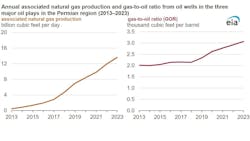Production of associated natural gas, which is natural gas produced from predominantly oil wells, has nearly tripled since 2018 in the three top-producing tight oil plays in the Permian region, according to a new report from the Energy Information Agency (EIA).
Associated natural gas from the Wolfcamp, Spraberry, and Bone Spring plays averaged a combined 13.7 billion cu. ft. per day (Bcf/d) in the first seven months of 2023, up from an average of 4.7 Bcf/d in 2018, EIA said, citing data from Enverus’ DrillingInfo platform. Associated natural gas production has grown due to increases in both crude oil production and the volume of natural gas per barrel of oil that a well produces, the gas-to-oil ratio (GOR), among the oil wells in these three plays.
Any increase in the GOR in an oil well means more natural gas per barrel of oil is being produced. EIA defines oil wells as those with a GOR of less than or equal to 6.0 thousand cu. ft. of natural gas per barrel of oil produced (Mcf/b). Wells with a GOR of more than 6.0 Mcf/b are classified as natural gas wells.
The Spraberry, Wolfcamp, and Bone Spring plays produce most of the associated natural gas within the Permian region. In 2023, these three plays produced 13.2 Bcf/d more associated natural gas than in 2013. Higher crude oil production accounted for 65% of the increase in natural gas production, and 35% of the increase came from a higher GOR, which rose from 2.0 Mcf/b in 2013 to 3.1 Mcf/b in the first seven months of 2023.


